An explosive mix of problems threw the country into chaos, while, by fueling social tensions, Trump’s propaganda machine is only making things worse
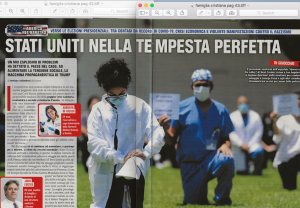 An unlucky strike within an unlucky strike, … within an unlucky strike!
An unlucky strike within an unlucky strike, … within an unlucky strike!
The Coronavirus could have not hit America at a worse time: not only in an election year, but with a White House clearly more worried about a possible move than about the worst health, economic and social crisis in living memory.
In other words, it is a “cubed” catastrophe – at least until next November 3rd. Only then, regardless of the winner (assuming that a definite one comes out of the polls), when neither the right nor the left will need to politicize everything – from masks to images of street killings – perhaps everyone will really begin to perceive the “side effects” of the virus. And without the distorted lense of “partisan” politics, maybe they even start to solve some.
In the meantime, here, we continue to get infected by Covid19, and unfortunately to die from it, at world-record rates: after the initial peak, which reached the same number of daily victims as September 11th, now we are steadily travelling at the speed of one thousand deaths a day (the equivalent of two Boeing 747s full, with crew and all). On holiday weekends like the Labor Day one that just passed, between beaches, barbecues and various gatherings, the virus seems to be celebrating, too. Soon the death count will reach 200,000 (the equivalent of all American soldiers fallen in Vietnam, Korea and Europe during WW1 – where the ‘Spanish flu’ mowed down more people than the machine gun). Even in new infections, the US is second to none. The psychological threshold of 7,200,000, which means two sick Americans out of every hundred, is just around the corner. Of course, about half have already healed, but not all of them – it is well known – without long-term consequences.
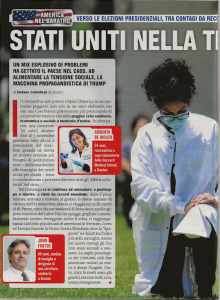 “My senses of taste and smell had disappeared completely. Now the taste is back, but the smell is not. Before, I could tell if there was sugar in the coffee just by its aroma … “ A resigned Assunta de Rienzo, researcher and head of laboratory at Harvard Medical School, remembers. “Ah, the coffee …” she continues with a sigh “now I just feel something for three seconds then nothing more”. As a world expert in Mesothelioma, Dr. DeRienzo, knows lung diseases well; yet when last April she suffered the first cough and headaches (“apocalyptic ones” according to her not-so-medical but very effective definition) she thought it could be anything but Covid.
“My senses of taste and smell had disappeared completely. Now the taste is back, but the smell is not. Before, I could tell if there was sugar in the coffee just by its aroma … “ A resigned Assunta de Rienzo, researcher and head of laboratory at Harvard Medical School, remembers. “Ah, the coffee …” she continues with a sigh “now I just feel something for three seconds then nothing more”. As a world expert in Mesothelioma, Dr. DeRienzo, knows lung diseases well; yet when last April she suffered the first cough and headaches (“apocalyptic ones” according to her not-so-medical but very effective definition) she thought it could be anything but Covid.
“I was obsessive my prevention practices: I wore mask and gloves everywhere, I quarantined my groceries and my parcels for 3 days, and yet …!” More than the symptoms, however, it was her state of mind that made her suffer the most. “You want to know how your lungs are, and they tell you ‘within 7 days you could get worse, but don’t you dare to show up here: if you are really sick go to the emergency room!’” Now Brigham, the hospital where I work, has the entire ground floor dedicated to Covid, but at the time there were many sick people: maybe not at the levels of Bergamo and Brescia, but even here the hospitals didn’t know what to do next!
Here, as everywhere, Covid took everyone by surprise. However, in a world medical mecca like Boston, the reaction came earlier and proved effective than elsewhere.
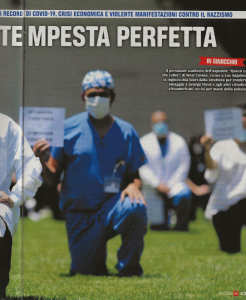 “COVID 19 has radically changed my professional life both as a manager of a health facility and as a practicing doctor: it has complicated even the simplest things, like letting patients fill out a form with a pen” explains Dr. John Foster, internist and general practitioner with 30 years of experience. “Nevertheless, Massachusetts has been – and currently is – a model in the management of the Coronavirus, with incredible coordination between the local government and the healthcare community. Our current positivity rate is around 1%. And many companies have been able to safely reopen. We are proof that the alignment of government and scientists, with a coherent message and plan, leads to excellent results.”
“COVID 19 has radically changed my professional life both as a manager of a health facility and as a practicing doctor: it has complicated even the simplest things, like letting patients fill out a form with a pen” explains Dr. John Foster, internist and general practitioner with 30 years of experience. “Nevertheless, Massachusetts has been – and currently is – a model in the management of the Coronavirus, with incredible coordination between the local government and the healthcare community. Our current positivity rate is around 1%. And many companies have been able to safely reopen. We are proof that the alignment of government and scientists, with a coherent message and plan, leads to excellent results.”
Unfortunately, the same does not happen in the rest of the nation. And while Dr. Foster does not spell it out but somehow implies it, Dr. DeRienzo, who has much less to lose – and much more anger to vent – clearly complains about it: “Remember the President’s speech at the Republican Convenvion, on the White House lawn with all those people without masks? Regardless of what he said, I saw it as a clear insult: to me, to all the sick and all the dead!”
Father Andrea Vicini, a teacher of Bioethics at Boston College for ten years, echoes Dr DeRienzo’s reflections. “As in all emergencies, such as earthquakes or hurricanes, Covid has highlighted not only the capabilities, but above all the good faith and sense of the common good of those who govern us. It is true that the US is a federal country where each state does basically what it wants, but at the central level there is a leadership and responsibility role that has not been properly fulfilled so far. “
An attentive observer of public affairs, Father Vicini has no doubts that the ‘American dream’ has become “more false and more deceptive than ever” for the most fragile sections of society. The virus – with the consequent economic crisis it brought as its dowry – has dramatically highlighted the difference between those who can afford to avoid it (for example, working from home, traveling by car, or simply having access to healthcare) and those who cannot. And he has even less doubt about the current inability of politics to do something about it. Even the numbers of the real economy – which despite a timid recovery continue to remind us of the great depression of the 1930s – are presented by both sides for their own ends.
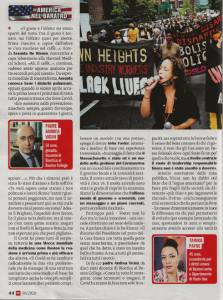 “We are faced with an appropriation and distortion of facts for political purposes” concludes Vicini, weighing his words one by one “Instead of seeking compromise and common platforms for dialogue, every attempt at collaboration is seen as a betrayal. This is as true for Covid as it is for the Black Lives Matter protests “.
“We are faced with an appropriation and distortion of facts for political purposes” concludes Vicini, weighing his words one by one “Instead of seeking compromise and common platforms for dialogue, every attempt at collaboration is seen as a betrayal. This is as true for Covid as it is for the Black Lives Matter protests “.
When it comes to the demonstrations – which have upset this restless and disturbing American summer since the murder of George Floyd – communication becomes brazenly biased. The two sides already spoke completely different languages, and less than two months before the elections, no one has any interest, in being a translator. There is an America, exasperated by the virus and the crisis, that tends to generalize the situation one stereotypical way or the other, and a political climate, amplified by cheerleading media, that keep throwing fuel on it. All this to the detriment of the ancient and sacrosanct reasons for the protest itself.
Tamika Payne, consultant on human rights for, among others, the UN and the US State Department, summarizes the spirit of Black Lives Movement in one sentence: “Many have not yet come to terms with the past of oppression that gave life to our country. Take the Republican election slogan for example: ‘Make America Great Again’ does not include a lot of people for whom America has never been “great” but actually quite the contrary.”
Not new to street demonstrations, Payne says she participated in the first march held for George Floyd in New York where she lives, convinced that it was a peaceful event, and that in fact she found herself at the center of horrible clashes. “I immediately noticed the aggressive attitude of the police who for no reason were beating, shoving, tear-gassing, and loading demonstrators on vans… including me! At that point I decided to go every day, also in order to explain the younger ones how to behave and what their rights were.” Payne says she is satisfied like many others – and not just African Americans like her – that certain issues have finally come to the fore, but she is not convinced that in an election year the movement will lead to something concrete. “If America manages to politicize a virus, what hope do we have of working together on a complex problem such as racial injustice?”
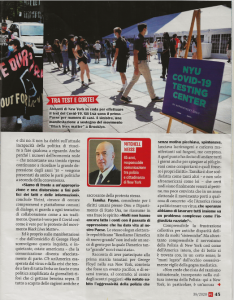 The collective frustration with persistent racial disparities, defined by many as systemic, is undoubtedly understandable. Also understandable is the nervousness of the police forces in New York and much of America, which suddenly found themselves, in a certain sense, “hands tied” by the obsessively watchful eye of the media pillory.
The collective frustration with persistent racial disparities, defined by many as systemic, is undoubtedly understandable. Also understandable is the nervousness of the police forces in New York and much of America, which suddenly found themselves, in a certain sense, “hands tied” by the obsessively watchful eye of the media pillory.
“I do not believe that there is institutional racism, imbedded in the internal culture of the police. Particularly here, in New York, it is an accusation that does not hold up, as our staff is made up of 65% minorities, of “non-whites”” states Mitch Weiss, responsible for relations and communications between the NYPD (the largest police force in the world) and the inhabitants of the Big Apple – clearly one of the most demanding and delicate jobs in America today. “Clearly, as in all organizations there is good and bad. For sure, we also have some officers who bear prejudices and unfortunately act accordingly. We do everything possible to isolate them and if necessary punish them. There are both federal and local guidelines for that, and the investigations are public, but we follow precise procedures: whoever is found guilty is sanctioned or condemned. But you can’t – and you shouldn’t – fire or throw anybody in jail on the spot just because the street asks for it “.
Unfortunately, the streets of America, from the Floyd case onwards, ask not only to find and punish – seriously and possibly swiftly – the “bad apples”, but often also to reduce (by removing public funds) and in certain extreme cases even abolish, the whole orchard.
So it is in Portland, Oregon, on the opposite side of this nation-continent, where for 100 consecutive days a small but combative group of demonstrators occupied a symbolic area of the city center: “It is not the first time that something gets occupied here. This is a very “left-wing” city, and it is quite tolerated in the local culture” explains Beth Nakamura, a highly decorated photojournalist of the Oregonian, the main local newspaper, who spent most of the one hundred nights – camera in hand – on the field.
“It was a 3-act drama: Act One, protests over the death of George Floyd, as everywhere. Act Two, things calm down but about 200 protesters occupy a couple of blocks, which include a Federal Court: the media notice it, it becomes a national case, Trump sends a completely militarized federal police, ordinary people rise up, and the protesters become, again, thousands. Act Three, the drama becomes tragedy: Trump supporters descend to Portland from the surrounding areas, many armed, and someone gets killed! One on each side!! Just as we journalists had feared from the beginning!” Nakamura, who in twenty years had never seen anything like it in her city, doesn’t have much hope for the fourth Act. “I fear that these dead will become martyrs and that it will not end here: for sure it will take years for this collective trauma to pass”.
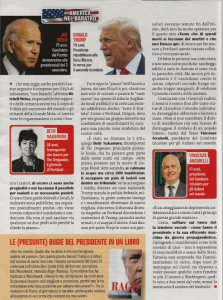 In fact the protests were not, and are not, all peaceful: looting, as well as cars and buildings on fire, were standard in several cities (even unlikely ones). But even more disturbing is the vandalism against the statues, guilty, according to not only marginal fringes, of celebrating the nation’s racist past. Begun with the Southern generals (who fought in the Civil War to preserve slavery), this unfortunate trend has extended to the many statues of Christopher Columbus – a symbolic figure for Italian Americans – smeared, damaged, demolished and thrown into the sea. All this amidst the indulgence (apart from some belated and timid condemnation) of left-leaning politicians and media. “The right to demonstrate cannot be interpreted as a license to destroy the symbol of an entire people” roars Vincenzo Arcobelli from Texas, where he lives. As President of the Tricolor Committee for Italians Around the World, he voices the complaints of many disgusted Italian American communities he is in touch with throughout the country. “It is a deplorable, undemocratic attitude, and it stands against all the principles of this great nation.”
In fact the protests were not, and are not, all peaceful: looting, as well as cars and buildings on fire, were standard in several cities (even unlikely ones). But even more disturbing is the vandalism against the statues, guilty, according to not only marginal fringes, of celebrating the nation’s racist past. Begun with the Southern generals (who fought in the Civil War to preserve slavery), this unfortunate trend has extended to the many statues of Christopher Columbus – a symbolic figure for Italian Americans – smeared, damaged, demolished and thrown into the sea. All this amidst the indulgence (apart from some belated and timid condemnation) of left-leaning politicians and media. “The right to demonstrate cannot be interpreted as a license to destroy the symbol of an entire people” roars Vincenzo Arcobelli from Texas, where he lives. As President of the Tricolor Committee for Italians Around the World, he voices the complaints of many disgusted Italian American communities he is in touch with throughout the country. “It is a deplorable, undemocratic attitude, and it stands against all the principles of this great nation.”
Of course, painting the protesters as Bolshevik hordes thirsting for chaos – as the President and his propaganda machine do – is not exactly the epitome of responsibility and leadership either. However, it is not surprising to see the current administration blow on the flames of social tension: after months of lying about Covid, seeing a few more hearses pass by will not be particularly upsetting to them. The real terror in the White House, two months before the vote, is only caused by the specter of the U-Haul moving truck!
